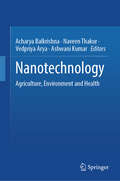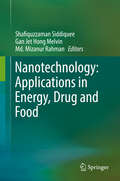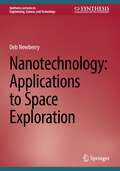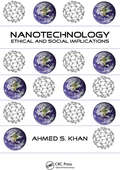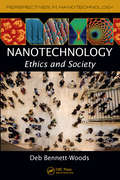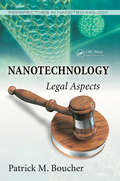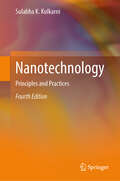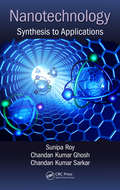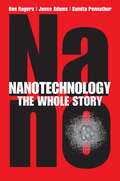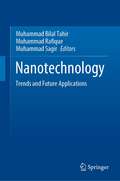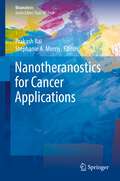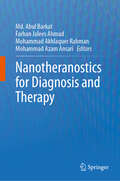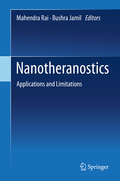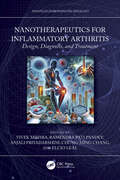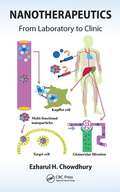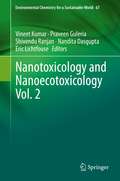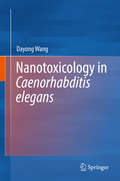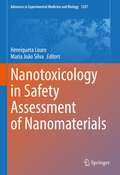- Table View
- List View
Nanotechnology: Agriculture, Environment and Health
by Ashwani Kumar Acharya Balkrishna Naveen Thakur Vedpriya AryaThis book presents an update on the state of the art in nanobiology and various nanoparticle synthesis and characterization methods. Further, the application of nanomaterials in agriculture (nanobiofertilizers and nanobiopesticides), environmental remediation (bio-nanoaugmentation), and public health (diagnosis, treatment, and drug delivery) is also a key area of this book. This book serves as a roadmap for researchers to fill various gaps by designing and organizing future research. It offers a crucial reference for academic researchers in nanotechnology, medicine, material science, toxicology, agriculture, environmental science, and biomedical science.
Nanotechnology: Applications for Environmental Protection and Sustainability (Nanotechnology in the Life Sciences)
by Martin F. Desimone Rajshree B. Jotania Ramdas B. Khomane Ratiram G. ChaudharyNanotechnology has the potential to revolutionize the way we address environmental challenges. From water purification, renewable energy, and pollution remediation, nanomaterials offer new and innovative solutions to some of the most pressing problems facing our planet. This book discusses the latest advances in nanotechnology and its potential applications for environmental protection and sustainability. The book covers a wide range of topics, from the fundamental principles of nanotechnology to specific case studies of nanomaterials being used to solve real-world environmental problems. This book is intended for researchers, students, professionals, and policymakers.
Nanotechnology: Applications in Energy, Drug and Food
by Shafiquzzaman Siddiquee Gan Jet Hong Melvin Md. Mizanur RahmanApplications of nanotechnology are the remarkable sizes dependent on physiochemical properties of nanomaterials that have led to the developed protocols for synthesizing nanomaterials over a range of size, shapes and chemical compositions. Nanomaterials are normally powders composed of nanoparticles which exhibit properties that are different from powders. Nanotechnology is the engineering of functional systems at the molecular scale with their wide applications in energy sector, including -but not limited to- energy resources, energy conversion, energy storage, and energy usage; drug delivery systems including- safety concerns, perspective, challenges, target therapeutics for cancer, neurodegenerative diseases and other human diseases, nanomaterials based tissue engineering; and food sectors including to- food safety and quality, opportunities, challenges, nanomaterials based enhancing food packing, and determination of foodborne pathogens, agro and marine food, analysis of market, regulations and future prospects. The utilization of nanotechnology in the energy field will be emphasized and highlighted, in accordance to their prominent and high impact in this particular field. Recent trends and significant benefits of nanotechnology in the energy field will be revealed to the readers, and their promising advanced applications will be discussed.
Nanotechnology: Applications to Space Exploration (Synthesis Lectures on Engineering, Science, and Technology)
by Deb NewberryThe convergence of 1) the intensification of space exploration and 2) the increasing understanding of the world at the atomic and molecular level, nanotechnology, has resulted in a synergy of discoveries and innovations. The result of this synergy may result in leaps in the exploration beyond the surface of the earth but also improve life on our home planet. The content describes the challenge of escaping the earth’s surface, remaining in orbits around our planet, and landing and surviving on worlds away. The associated space environments and variables are covered in general terms and not in an encyclopedic manner. Discoveries in the nanotechnology arena as they can be applied to space exploration are also covered in an understandable manner. This book is a must for people who are working in the “space” industry who need to know not only more about the many aspects of their industry but also must understand nano-scale implications for the future. Likewise, participants in the nanotechnology arena who want to understand the challenges of space exploration will find critical information in this text.
Nanotechnology: Ethical and Social Implications (Nano and Energy)
by Ahmed S. KhanAdvances in nanotechnology are transforming the ways of creating materials and products, leading society to the threshold of a second industrial revolution. However, future opportunities will depend significantly on how nanotechnology stakeholders deal with the short-term and long-term benefits, limitations, uncertainties and risks of nanotechnolog
Nanotechnology: Ethics and Society (Perspectives in Nanotechnology)
by Deb Bennett-WoodsFrom manufacturing to medicine, nanotechnology implies revolutionary change. However, the sweeping changes wrought by a technological advance of this magnitude are likely to come at a price that includes unforeseen environmental impact, disruptions in industry, displacement of workers, and deeply controversial applications of the technology and its offspring. Nanotechnology: Ethics and Society provides a conceptually clear and straightforward ethical framework, in which pragmatic questions can be raised regarding the impact of nano-related technologies. The book focuses on general issues related to nanotechnology in nanomaterials and manufacturing as well as impacts on the marketplace and workforce. After an overview of the nanotechnology revolution, the text illustrates key concepts in the assessment model and then applies this model to a case study related to human enhancement technologies. It also offers an ethical agenda for addressing the challenges of nanotechnology. Nanotechnology promises to be the next great technological revolution. This important volume provides a framework for deciding how best to take advantage of nanotechnology opportunities while also minimizing the harm of negative effects.
Nanotechnology: Health and Environmental Risks, Second Edition (Perspectives in Nanotechnology)
by Jo Anne ShatkinShould you adopt nanotechnology? If you have already adopted it, what do you need to know? What are the risks? Nanomaterials and nanotechnologies are revolutionizing the ways we treat disease, produce energy, manufacture products, and attend to our daily wants and needs. To continue to capture the promise of these transformative products, however, we need to ask critical questions about the broader impacts of nanotechnology on society and the environment. Exploring these questions, the second edition of Nanotechnology: Health and Environmental Risks gives you the latest tools to understand the risks of nanotechnology and make better decisions about using it. Examining the state of the science, the book discusses what is known, and what still needs to be understood, about nanotechnology risk. It looks at the uses of nanotechnology for energy, industry, medicine, technology, and consumer applications and explains how to determine whether there is risk—even when there is little reliable evidence—and how to manage it. Contributors cover a wide range of topics, including: Current concerns, among them perceived risks and the challenges of evaluating emerging technology A historical perspective on product safety and chemicals policy The importance of being proactive about identifying and managing health and environmental risks during product development How the concepts of sustainability and life cycle assessment can guide nanotechnology product development Methods for evaluating nanotechnology risks, including screening approaches and research How to manage risk when working with nanoscale materials at the research stage and in occupational environments What international organizations are doing to address risk issues How risk assessment can inform environmental decision making Written in easy-to-understand language, without sacrificing complexity or scientific accuracy, this book offers a wide-angle view of nanotechnology and risk. Supplying cutting-edge approaches and insight, it explains what types of risks could exist and what you can do to address them. What’s New in This Edition Updates throughout, reflecting advances in the field, new literature, and policy developments A new chapter on nanotechnology risk communication, including insights into risk perceptions and the mental models people use to evaluate technological risks An emphasis on developing nanotechnology products that are sustainable in the long term Advances in the understanding of nanomaterials toxicity Cutting-edge research on occupational exposure to nanoparticles Changes in the international landscape of organizations working on the environmental, health, and safety aspects of nanotechnologies
Nanotechnology: Legal Aspects (Perspectives in Nanotechnology)
by Patrick M. BoucherExisting laws have a generality that permits them to be applied to nanotechnology, but eventually it will be necessary to generate legislation targeted to issues specific to nanotechnology. As nanotechnology continues to develop into commercially viable products, legal doctrines are increasingly likely to play an important role in protecting intellectual property, facilitating financial transactions, and handling health, safety, and environmental issues.Nanotechnology: Legal Aspects provides thorough, yet comprehensible overview of different legal doctrines that are relevant to nanotechnology and explains how they may apply in the development, commercialization, and use of nano-products. The book is divided into three parts that correspond to the different phases in the lifecycle of nano-products: Protection, Regulation, and Liability. The in-depth coverage of these topics in a single source sets this work apart from others at the interface of law and nanoscience. Accessible to those without specific training in either nanotechnology or law... Nanotechnology: Legal Aspects offers a reader-friendly and affordable alternative that appeals to nano-aware audiences as well as legal professionals, students, and scientists who wish to build a greater understanding of the legal aspects of nanotechnology.
Nanotechnology: Principles and Practices
by Sulabha K. KulkarniThe book is meant to acquaint the readers about the foundations of Nanotechnology like what is Nanotechnology, why Nanotechnology, what are new Nanomaterials, how to synthesize Nanomaterials and what are the techniques for these, how to analyze Nanomaterials with advanced microscopes, and spectroscopies as well as applications of Nanotechnology. Certainly, you will get answers to above questions as in the previous editions and also find new additions in this edition. You will find the inclusion of Mechanical bond, Atomic Layer Deposition (ALD) Technique, a new Chapter on Carbon Nano family, Wearable Electronics, Nano generators using. piezoelectric and triboelectric effects. Nanosensors and Nanocomposites also are included in this fourth edition of the book.
Nanotechnology: Synthesis to Applications (Engineering Materials)
by Chandan Kumar Sarkar Sunipa Roy Chandan Kumar GhoshNano particles have created a high interest in recent years by virtue of their unusual mechanical, electrical, optical and magnetic properties and find wide applications in all fields of engineering. This edited volume aims to present the latest trends and updates in nanogenerators, thin film solar cells and green synthesis of metallic nanoparticles with a focus on nanostructured semiconductor devices. Exclusive chapter on electrical transport of nanostructure explains device physics for material properties for reduced dimensions. Additionally, the text describes the functionality of metallic nanoparticles and their application in molecular imaging and optical metamaterials. Piezoelectric nanogenerators has been touched upon from the energy perspective as well. Key Features: • Organized contents on Nanogenerators, VOC sensing, nanoelectronics, and NEMS. • Discusses eco-friendly green synthesis methods for metallic nanoparticles. • Touches upon low power nano devices (e.g. nanogenerators) for energy harvesting with quantum mechanical study. • Thin film/heterojunction based high efficiency solar cell addressed aimed at reducing global energy consumption.
Nanotechnology: The Whole Story
by Ben Rogers Jesse Adams Sumita PennathurWinner of an Outstanding Academic Title Award from CHOICE MagazineTransistors using one electron at a time. Seemingly transparent sunscreens made with titanium dioxide particles that block harmful UV rays. Nanometer-sized specks of gold that change color to red and melt at 750 C instead of 1,064 C. Nanotechnology finds the unique properties of thin
Nanotechnology: Therapeutic, Nutraceutical, and Cosmetic Advances (Nutraceuticals Ser. #4)
by Yashwant Pathak Bhaskar Mazumder Subhabrata Ray Paulami PalToday we find the applications of nanotechnology in all spheres of life. Nanotechnology: Therapeutic, Nutraceutical and Cosmetic Advances discusses recent advances in the field, particularly with therapeutics, nutraceuticals and cosmetic sciences. <P><P>Therapeutics is an area which has perhaps benefitted the most, although nanoscience and technology have quietly entered the realms of food science and are playing pivotal roles in the efficient utilization of nutraceuticals. Finally, even before therapeutics came cosmetics and companies started marketing unique products embedding the beneficial and advanced properties enabled by the use of nanostructures. This book highlights trends and applications of this wonderful new technology.
Nanotechnology: Trends and Future Applications
by Muhammad Sagir Muhammad Bilal Tahir Muhammad RafiqueThis book presents the basic and fundamental aspects of nanomaterials, its types, and classifications with respect to different factors. It contains methods of preparation and characterization of unique nanostructured materials. Consisting of six chapters, this book appeals to a wide readership from academia and industry professionals and is also useful to undergraduate and graduate students focusing on nanotechnology and nanomaterials, sustainable chemistry, energy conversion and storage, environmental protection, opto-electronics, sensors, and surface and interface science. It also appeals to readers who wish to know about the design of new types of materials with controlled nanostructures.
Nanotechnology: Understanding Small Systems, Third Edition (Mechanical and Aerospace Engineering Series)
by Ben Rogers Jesse Adams Sumita PennathurAn Accessible, Scientifically Rigorous Presentation That Helps Your Students Learn the Real StuffWinner of a CHOICE Outstanding Academic Book Award 2011"� takes the revolutionary concepts and techniques that have traditionally been fodder for graduate study and makes them accessible for all. � outstanding introduction to the broad field of nanotech
Nanotheranostics for Cancer Applications (Bioanalysis #5)
by Prakash Rai Stephanie A. MorrisThis book is the first to focus specifically on cancer nanotheranostics. Each of the chapters that make up this comprehensive volume is authored by a researcher, clinician, or regulatory agency member known for their expertise in this field. Theranostics, the technology to simultaneously diagnose and treat a disease, is a nascent field that is growing rapidly in this era of personalized medicine. As the need for cost-effective disease diagnosis grows, drug delivery systems that can act as multifunctional carriers for imaging contrast and therapy agents could provide unique breakthroughs in oncology. Nanotechnology has enabled the development of smart theranostic platforms that can concurrently diagnose disease, start primary treatment, monitor response and initiate secondary treatments if required. In oncology, chemotherapeutics have been routinely used. Some drugs have proven effective but all carry risks of adverse side effects. There is growing interest in using remotely triggered drug delivery systems to limit cytotoxicity in the diseased area. This book reviews the use of theranostic nanoparticles for cancer applications over the past decade. First, it briefly discusses the challenges and limitations of conventional cancer treatments, and presents an overview of the use of nanotechnology in treating cancer. These introductory chapters are followed by those exploring cancer diagnosis and a myriad of delivery methods for nanotherapeutics. The book also addresses multifunctional platforms, treatment monitoring, and regulatory considerations. As a whole, the book aims to briefly summarize the development and clinical potential of various nanotheranostics for cancer applications, and to delineate the challenges that must be overcome for successful clinical development and implementation of such cancer theranostics.
Nanotheranostics for Diagnosis and Therapy
by Farhan Jalees Ahmad Md. Abul Barkat Mohammad Azam Ansari Mohammad Akhlaquer RahmanThis book provides an updated account of recent advancements in the field of nanotechnology-based theranostics with special emphasis on their application in the diagnosis and treatment of various types of cancer and neurological diseases. The book is divided into two sections; the first section provides an introduction to the nanoscale theranostics & radiopharmaceuticals. The second section highlights the importance of nanoscale theranostics in disease diagnosis & treatment. It presents the potential of nanotechnology for developing nanomedicine and nanotheranostics for the diagnosis and treatment of a variety of illnesses. Further, the book discusses the usefulness of theranostic nanoparticles in the diagnosis of disease, identification of location, and stage, and in providing information about the therapy response. In addition, the book focuses on the clinical applications of nanomaterial radiolabeling in nuclear imaging of cancer and other illness. Towards the end, the bookexamines the toxicity, regulatory protocols, and future aspects of clinical applications of theranostics. This book is an invaluable source for academicians and industrial scientists working in multiple healthcare fields like pharmaceutical and biological sciences, life sciences, biotechnology, biomedical engineering, and nanobiotechnology.
Nanotheranostics: Applications and Limitations
by Mahendra Rai Bushra JamilThis book is specifically designed to provide information about various nanocarriers currently developed under the emerging field of nanotheranostics for a sustained, controlled, and targeted co-delivery of diagnostic and therapeutic agents. Diverse theranostic applications of nanotechnology and their limitations are also addressed. It integrates nanobiotechnology with theranostic applications. The combined term nanotheranostics has diverse application particularly in chemotherapy and other infectious diseases.Among other topics addressed are antimicrobial resistance, targeting intra-cellular pathogens, viruses and bacteria, chemotherapy, cancer therapeutics, and inflammatory disorders. This interdisciplinary volume is essential for a diverse group of readers including nanotechnologists, microbiologists, biotechnologists, bioengineering and bioprocess industry.
Nanotherapeutics for Inflammatory Arthritis: Design, Diagnosis, and Treatment (Advances in Bionanotechnology)
by Vivek Mishra Anjali Priyadarshini Ramendra Pati Pandey Chung-Ming Chang Elcio LealNanotherapeutics for Inflammatory Arthritis: Design, Diagnosis, and Treatment highlights nanobiotechnology and its therapeutic applications in the field of inflammatory arthritis, the interaction of nanomaterials in the biological systems, and clinical development of nanomedicines. It also covers the discovery of personalized therapeutics, diagnostics, and nanoparticular delivery systems, the role of bioinformatics nanobiotechnology in personalized oncology. The use of nanosensors for the detection and current challenges in the development of personalized medicine is explained including recent nanotechnology-based strategies.Features: Covers all the fundamental information about nanotechnology and inflammatory arthritis. Highlights the interaction of nanomaterials in the biological systems, and the clinical development of nanomedicines for inflammatory arthritis. Explores the discovery of personalized therapeutics, diagnostics, and nanoparticle delivery systems. Reviews the current challenges in the development of personalized medicine as well as translation of nanomedicine with combination therapy. Discusses the toxicology of using nanomedicines and the risks associated with the use of these nanomedicines. This book is aimed at researchers and professionals in nanotechnology, biomaterial, drug delivery, and inflammatory arthritis.
Nanotherapeutics: From Laboratory to Clinic
by Ezharul Hoque ChowdhuryThe emergence of nanotherapeutics is attributable to the integration of nanotechnology, recombinant DNA technology, and synthetic organic chemistry with medicine for treating critical human diseases in a more efficient and specific molecular approach than therapy with conventionally-designed and formulated drugs. Nanotherapeutics: From Laboratory t
Nanotoxicology and Nanoecotoxicology Vol. 1 (Environmental Chemistry for a Sustainable World #59)
by Eric Lichtfouse Vineet Kumar Shivendu Ranjan Nandita Dasgupta Praveen GuleriaThis book discusses the basics of nanotoxicity and gives a detailed account of methods used for toxicity evaluation of nanomaterials. It also gives indepth coverage of the effect of different types of nanomaterials, including organic and inorganic, on various aquatic animals, microorganisms and plants, and outlines recent challenges, regulatory frameworks and advances in nanotoxicity testing.
Nanotoxicology and Nanoecotoxicology Vol. 2 (Environmental Chemistry for a Sustainable World #67)
by Eric Lichtfouse Vineet Kumar Shivendu Ranjan Nandita Dasgupta Praveen GuleriaThis book reviews advances in the toxicity of nanomaterials, with a focus on nanosensors and nanotoxicity testing, biomagnification, biotransformation, nanosafety, genotoxicity, human health and remediation. This is the second volume on Nanotoxicology and Nanoecotoxicology published in the book series Environmental Chemistry for a Sustainable World.
Nanotoxicology in Caenorhabditis elegans
by Dayong WangThis book focuses on the toxicity of engineered nanomaterials (ENMs) and their underlying physicochemical, cellular, physiological, and molecular mechanisms. Further, it covers ENMs’ translocation and their targeted organ toxicology, and discusses chemical and pharmacological strategies used to combat nanotoxicity. Engineered nanomaterials (ENMs) are defined as materials with one or more dimensions of less than 100 nm, and have shown considerable promise in several areas of development. At the same time, the potential toxicity of ENMs for human health and environmental organisms is increasingly attracting attention. In addition to the typical properties of model animals, Caenorhabditis elegans is extremely sensitive to environmental toxicants, which makes it the ideal in vivo assay system for toxicological studies. C. elegans has been widely used in toxicity assessment and toxicological studies of environmental toxicants and stresses. This book provides a comprehensive summary of nanotoxicology research on C. elegans.
Nanotoxicology in Humans and the Environment (Molecular and Integrative Toxicology)
by Jamie R. Lead Shareen H. Doak Martin J. D. CliftThe book covers the area of ‘Nanotoxicology’ but primarily from the point of view of nanotoxicology at the interface with other disciplines including human toxicology; environmental toxicology; characterization, dose and transformations; regulation; public and elite group perceptions; and interactions with innovation.Nanotoxicology in Humans and the Environment is written for researchers in nanotoxicology in academia, industry, government, and research students. Given the rapid development, the maturing of the discipline and its importance in current regulation and industry development (eg REACH, TSCA), the book is very timely.
Nanotoxicology in Nanobiomedicine
by PK GuptaThis book provides that knowledge needed to introduce individuals to the most important research and content on nanotoxicology in nanobiomedicine. Nanotechnology is helping to considerably improve, even revolutionize many technology and industry sectors: information technology, homeland security, medicine, transportation, energy, food safety, and environmental science, among many others. There is an urgent need for a general reference textbook that presents the most recent information on the toxicity and its effects in all these sectors, biomedicine in particular. It includes historical information, nanotoxicology by subject area and or disease, sources of nanomaterials, drug delivery systems and more. Scientists, researchers, and students in all fields that use nanotechnology will find this book essential reading.
Nanotoxicology in Safety Assessment of Nanomaterials (Advances in Experimental Medicine and Biology #1357)
by Henriqueta Louro Maria João SilvaSince its advent, nanotechnologies are considered key enabling technologies that take advantage of a wide array of nanomaterials (NMs) for biomedical and industrial applications generating significant societal and economic benefits. However, such innovation increases human exposure to these substances through inhalation, ingestion or dermal contact raising public health concerns. Furthermore, the NMs’ specific physicochemical properties, that confer them unique beneficial characteristics, can also elicit nano-bio interactions leading to toxicity and concerns for public health. In addition, such properties can be affected by the surrounding matrix, particularly when incorporated in complex matrices such as food products, leading to secondary features potentially more relevant than primary characteristics for determining their toxicological outcome. These nano specific issues raise the question of whether the NMs may produce adverse outcomes that are not accounted for when using conventional toxicological approaches to assess their safety. Such uncertainties about the safety of NMs for human health and the environment may hamper a faster and more widespread exploration of their potentials. In response, the NMs definition has evolved, and nanotoxicology has developed towards new and more integrative approach methods to support regulatory and policy actions. This book provides a perspective on recent developments in the synthesis, application, and characterization of NMs and the related nanotechnologies, focusing on nanotoxicology for their accurate safety assessment early in the product development stage. The use of complex in vitro models, including multicellular systems and organoids, and “omics-based” approaches, such as transcriptomics or epigenomics, have greatly contributed to an in-depth understanding of the cellular and molecular mechanisms behind some NMs toxicity. Such mechanistic knowledge is equally addressed in this book and has set the basis for a predictive nanotoxicology approach building on adverse outcome pathways. In addition, considering the knowledge provided by the above-mentioned approaches, insights into risk assessment, standardization, and regulation of NMs are also included. Incorporating adequate nanosafety assessment early in the life-cycle of NMs will allow the implementation of the safe and sustainable-by-design paradigm enabling safety to keep pace with innovation. Chapters 10 and 15 are available open access under a Creative Commons Attribution 4.0 International License via link.springer.com.
